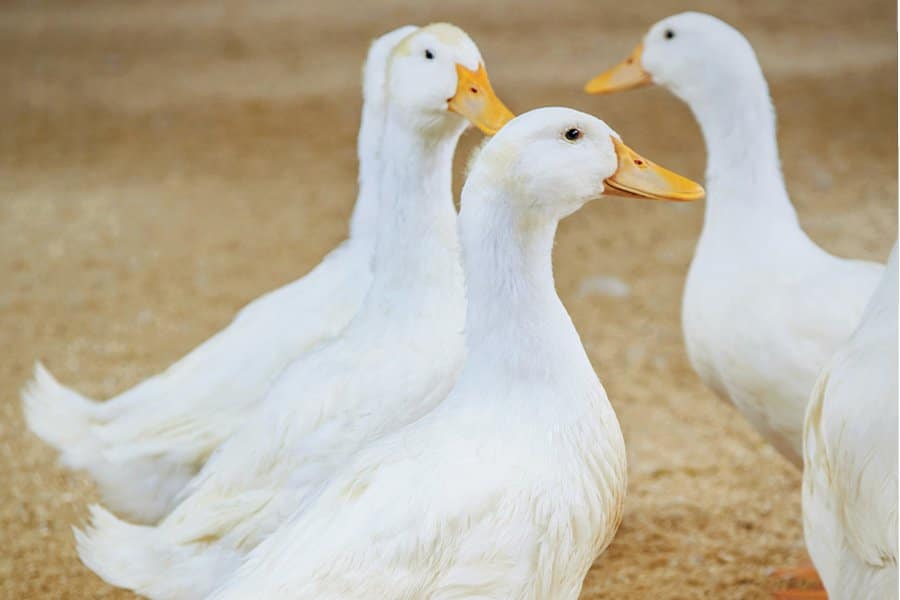
Hoosier Ducks: Hooked on Quack
Inside a former elementary school in Leesburg, next to the town’s Little League baseball diamonds, two third-generation duck farmers are plotting world domination. John and Scott Tucker, co-presidents of Maple Leaf Farms, have helped turn a little mom-and-pop operation in northern Indiana into the country’s biggest exporter of the fowl—a $170 million company now responsible for 70 percent of the nation’s White Pekin ducks.
That the world headquarters of anything could exist in this hamlet of 556 people seems preposterous. And indeed, Maple Leaf’s beginnings were more humble. In 1958, Don Wentzel, a former trader on the Chicago Board of Trade, purchased a small duck farm in Milford, a town just north of Leesburg. At the time, the U.S. duck industry was based in Long Island, where it had reigned since the 1870s, when the first flock of Pekin ducks arrived in New York fresh off a Yankee clipper from China. But why anchor the industry there, Wentzel wondered, far from the ducks’ food source in the grain-rich Midwest?
The first year, Wentzel’s upstart farm hosted some 280,000 ducks. Terry Tucker, a high-school student in Wentzel’s employ, stopped by Wentzel’s house one day to pick up his paycheck. In turn, he scored a “twofer,” as Terry’s son Scott puts it today: In addition to getting his money, he met Wentzel’s daughter, Sandra. The pair eventually married, and Tucker, a newly minted Purdue grad, joined the farm’s management outfit. By 1964, Maple Leaf had ramped up production to a million ducks a year.
When Wentzel died, Tucker agreed to helm Maple Leaf. His two sons, John and Scott, along with their sister, Tricia, who serves on the board of directors, represent the third generation of the company. Over the years, they have recruited local, family-owned farms, many Amish, into their fold. Now they boast 1,000 employees and 150 contract farms—which the Tuckers provide with ducks and technology—spanning four states, China, and Mexico. Each year, their partners gather in the still-standing bleachers of the school-turned-office’s basketball gym for their annual meeting.
The business also evolved from merely breeding ducks to becoming a global brand, with hatcheries, feather-harvesting operations, laboratories, and a genetics staff that commercial duck-growers in other countries rely on for support. With a refined feeding program, they developed a duck that is 27 percent leaner than what they produced nearly two decades ago. Meanwhile, they expanded their retail business, marketing duck to high-end restaurants across the world. That means their products—from roasted birds to duck bacon (which sold so quickly it required a new processing partner)—can be found not only on chalkboard menus across Indy, from Cerulean to Divvy, but on the shelves of grocery stores in all 50 states.
Nearly six decades after Wentzel’s hunch, Maple Leaf now leads the $250 million North American duck-meat market. The company even trademarked the phrase “The Healthy Red Meat,” capitalizing on the fact that duck contains fewer calories and grams of fat than skinless chicken breasts. At his 2009 inaugural luncheon, President Obama dined on Maple Leaf’s duck served with sour-cherry chutney, thanks to the company’s relationship with a Virginia–based catering company.
Lately, though, much of the company’s growth can be attributed to Asia. Chinese officials, wary of decades of domestic food-safety issues, wanted a U.S.-grown duck product for a populace where the meat is a dietary staple. Maple Leaf, for its part, was looking to diversify its international business. By 2010, Maple Leaf had entered into a joint venture with Shandong Yonghui Food to breed ducks in the Shandong province. The company now has 10 employees who speak Mandarin, including two at the Leesburg headquarters, which also features an Asian-themed conference room guarded by a replica of a terra cotta warrior. The nod to their hottest emerging market is warranted: Business in China, the Philippines, and South Korea accounts for 20 percent of Maple Leaf’s revenue.
Closer to home, John lives three houses down from his father, Terry, who remains CEO. And Scott and his family roost north of town to keep an eye on the production facility in Milford, where it all began. On Sundays, the 15-person Tucker crew eats family dinner together. John occasionally cooks his special Peking duck, which he prepares, in part, in his wife’s master bathtub, much to her chagrin.
The Tuckers can’t shake comparisons, though, to another prominent family in the duck business: The Robertsons of A&E’s reality hit Duck Dynasty, which centers on the Louisiana Duck Commander duck-call business. The Tuckers welcome the comparisons—they know the publicity is good for the duck business in general. A splashy 2013 profile of Maple Leaf in the industry publication Meat & Poultry even called them “The Real Duck Dynasty.” But there is one inescapable distinction between the Robertsons’ and Tuckers’ business models, which John is quick to underscore.
“They just sell the quack,” he says, with a wry smile. “We sell everything but the quack.”





